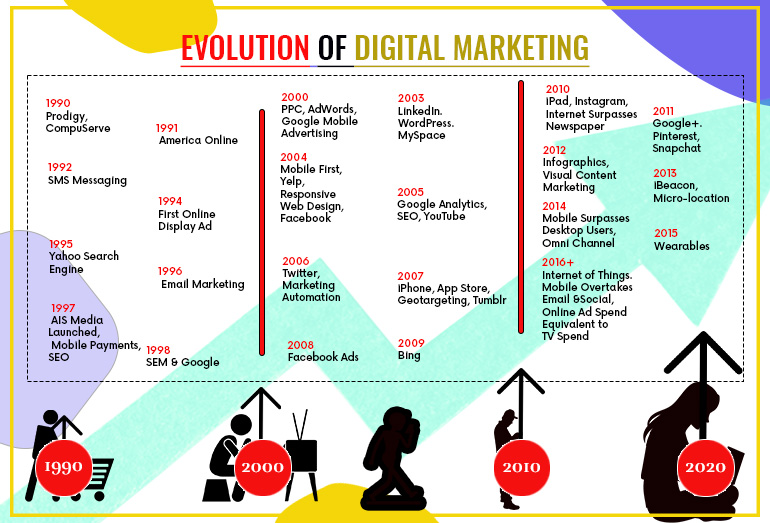Navigating the Evolution of Digital Marketing: A Journey Through Innovation

In the ever-evolving landscape of digital marketing, staying ahead requires a keen understanding of past developments, present trends, and future projections. From its humble beginnings to its current sophisticated state, digital marketing has undergone a remarkable evolution, reshaping the way businesses connect with their audiences. Let’s embark on a journey through its transformative phases.
Phase 1: Emergence of the Internet Age (1990s)
The inception of digital marketing can be traced back to the rise of the internet in the 1990s. Businesses started to explore this new frontier, utilizing basic websites and email marketing to reach their target audiences. Banner ads and pop-ups emerged as the early forms of online advertising, albeit crude by today’s standards.
Phase 2: The Search Engine Era (Early 2000s)
As search engines like Google gained prominence, search engine optimization (SEO) became a crucial strategy for businesses to improve their online visibility. Pay-per-click (PPC) advertising also gained traction, allowing advertisers to bid for keywords and display ads alongside search results. This era marked the beginning of data-driven marketing, as businesses leveraged analytics to optimize their campaigns.
Phase 3: Rise of Social Media (Mid to Late 2000s)
The mid-2000s witnessed the explosive growth of social media platforms like Facebook, Twitter, and LinkedIn. Marketers quickly recognized the potential of these platforms for targeted advertising and brand engagement. Influencer marketing emerged as a powerful tool for reaching niche audiences, while content marketing gained momentum as brands sought to create value for consumers through relevant and compelling content.
Phase 4: Mobile Revolution (2010s)
The proliferation of smartphones transformed digital marketing yet again, as consumers increasingly turned to mobile devices for online interactions. Mobile-responsive websites became essential, and location-based marketing enabled businesses to target consumers based on their geographic proximity. Apps also became a key channel for reaching and engaging with customers, driving the growth of mobile advertising and app store optimization (ASO).
Phase 5: Artificial Intelligence and Personalization (Present Day)
In today’s digital landscape, artificial intelligence (AI) is revolutionizing marketing practices. Machine learning algorithms analyse vast amounts of data to deliver personalized experiences and predictive insights. Chabot’s provide instant customer support, while AI-powered tools optimize ad targeting and campaign performance in real-time. Personalization has become the cornerstone of effective digital marketing, as consumers expect tailored experiences across all touchpoints.
Phase 6: The Future of Digital Marketing (Beyond 2020)
Looking ahead, the future of digital marketing promises further innovation and disruption. Emerging technologies such as augmented reality (AR), virtual reality (VR), and voice search are poised to reshape the way consumers interact with brands. Blockchain technology holds the potential to enhance transparency and security in digital advertising, while the Internet of Things (IoT) opens up new opportunities for hyper-targeted marketing based on real-time data from connected devices.
Conclusion: Embracing Change and Innovation
As digital marketing continues to evolve, one thing remains clear: adaptability is key to success. Businesses must stay abreast of the latest trends and technologies, constantly experimenting and refining their strategies to meet the ever-changing needs of consumers. By embracing change and innovation, marketers can harness the full potential of digital channels to drive growth, build brand loyalty, and stay ahead of the competition in the dynamic world of online marketing.
Contact Us:
https://www.weblogdigi.com/contact-us/ to get started on your digital marketing journey.
